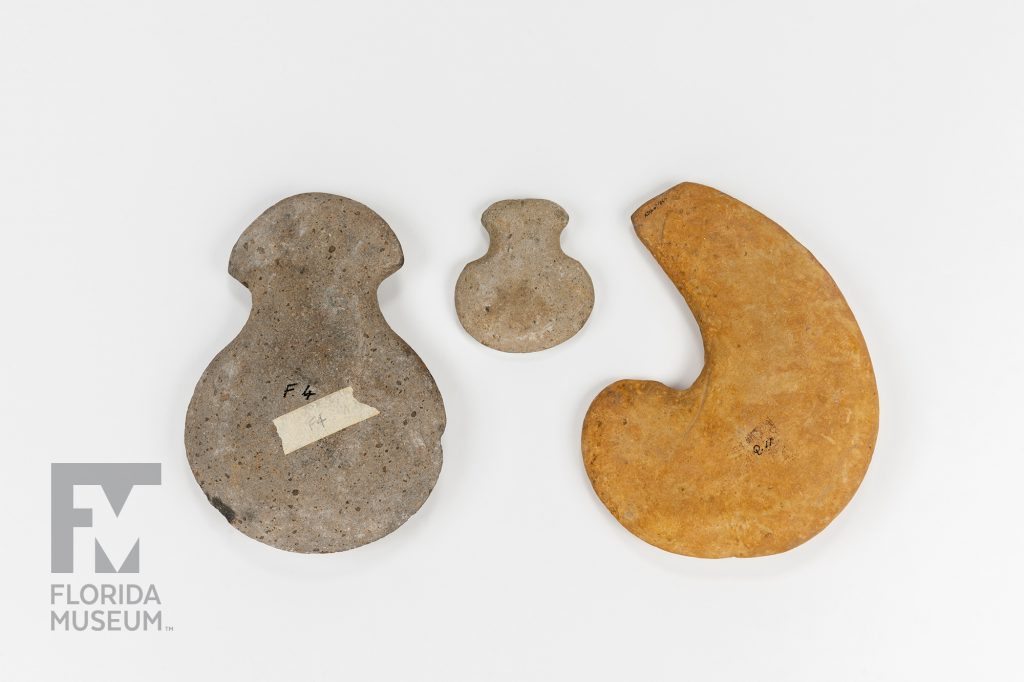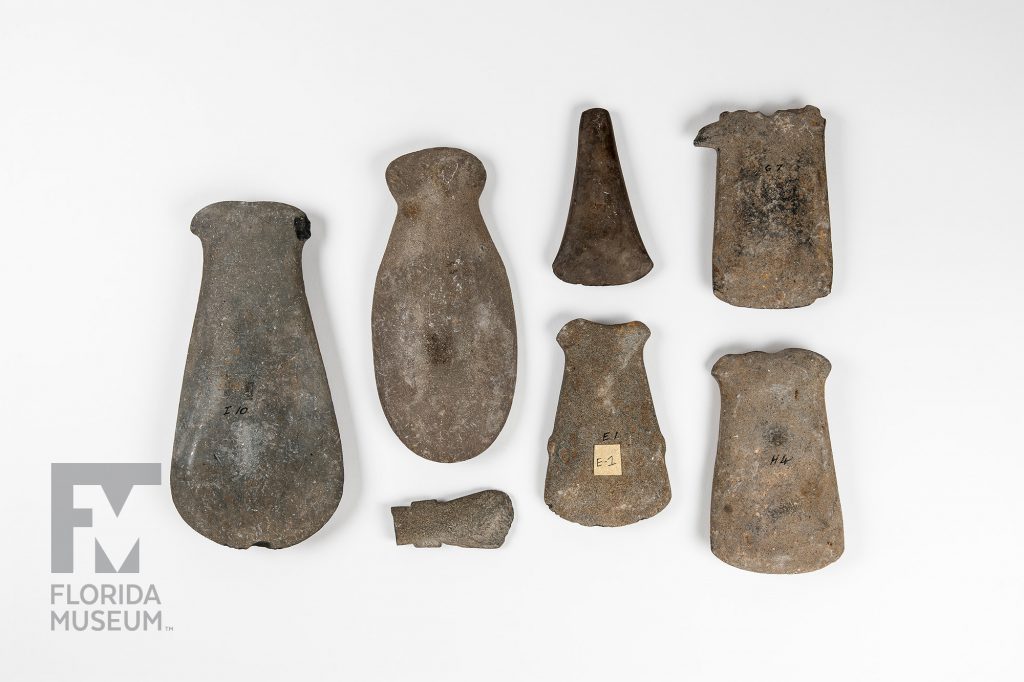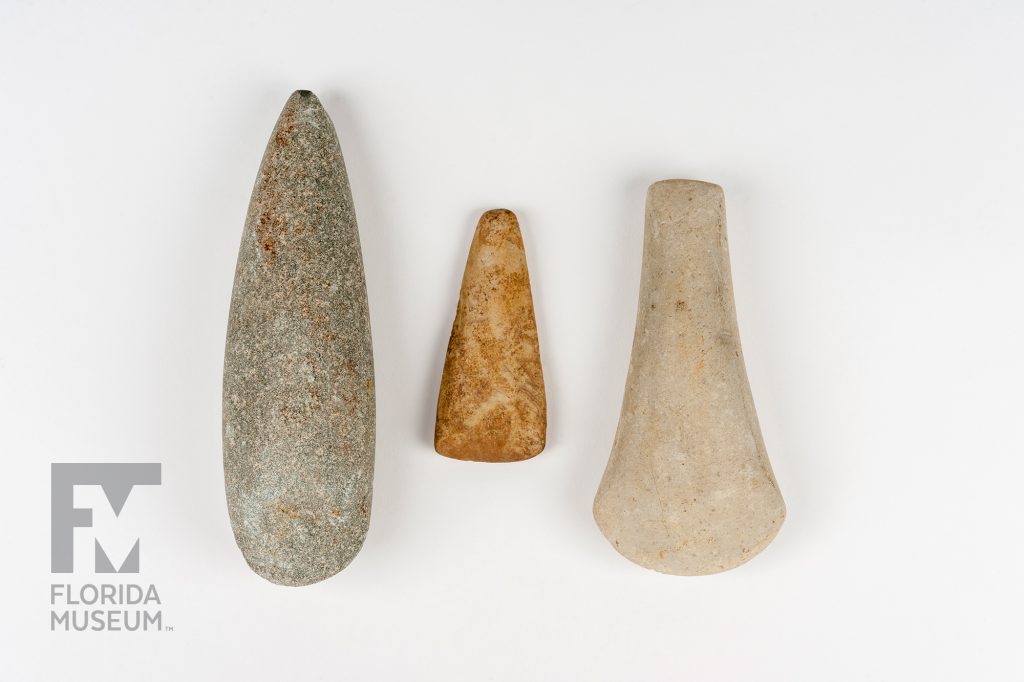These objects are shaped like axes, but don’t hold a sharp edge and are too heavy to be practical. They may have been used as hoes, or as a trade facilitator – unique objects given during negotiations to show how important (or not!) your trade partner was.
Summary
Stone Hoes
Made by Native Island peoples, Grenada
Dates to ~AD 200-1400
Collection
Story
Archaeologists often find objects that we’re not really certain what they were used for. The first way that we try and understand something is “What does the shape look like?” These objects for years have been called stone axes because they look sort of like a hatchet or an ax head, but if you look at the possible uses — the difference between what we call form (how something looks) and function (how it was used) — the stone doesn’t have the characteristics that we would associate with an axe. It will not hold a really sharp point and the stone — they are made from basalt — is very heavy and trying to chop down a tree or cut something with one of these is virtually impossible.
So here at the Florida Museum of Natural History we’ve been doing some research into what these might actually have been used for. We now believe that they were used as hoes: digging implements to help prepare gardens. We know that cassava and sweet potato were planted in mounds of earth and you need some sort of tool to mound up the earth in which to plant the stems and tubers. The heaviness is absolutely perfect for dealing with the very heavy clay soils that you find on many Caribbean islands. When we began the study we started to look at hoes that were made in other locations. So for example, in the Midwestern United States they make three different shapes of hoes: a rounded bit, a flat bit, and a more axe-like looking bit, and in fact those are the three shapes that we see with these Caribbean what were called axes and we’re now calling hoes.
The other thing about these is that objects often have more than one use. Some of these are just so large and so heavy that it would be almost impossible to use them as hoes as a useful object. One of the things we know is that societies that engage in exchange will often have an object that they present to their exchange partner as a symbol of how important that individual was. So for example, if I were to give you a very large, very well-made axe and then tell you the history of that axe — for example it was owned by so-and-so, who gave it to so-and-so, who gave it to someone else and now I’m giving it to you — that gives it a history of its own, its own biography — which increases the value of this object.
So while some of the smaller hoes were probably used in gardens and we look for evidence of that use: digging in the soil will leave scratches, flakes when they hit a rock and other traces that we can identify microscopically. But some of the larger objects were probably also used as an emblem or a symbol of the importance of gardening in these people’s way of life that was carried on as part of a larger system of exchange in which different materials were being traded back and forth between individuals.
Bill Keegan
Curator, Caribbean Archaeology*
Florida Museum of Natural History
Exhibit
On display Sept. 23, 2017-Jan. 7, 2018, Rare, Beautiful & Fascinating: 100 Years @FloridaMuseum celebrated the Museum’s rich history. Each Museum collection was asked to contribute its most interesting items and share the stories that make them special. Though the physical exhibit is closed, this companion website remains online, providing an opportunity to experience the Florida Museum’s most treasured specimens.
Exhibit Area: Objects Tell Stories
Theme: Ancient Artifacts
 Want to see more? Explore more than 300 breathtaking color photos of plants, animals, fossils and cultural heritage materials from the Florida Museum of Natural History’s collections in the award-winning book All Things Beautiful available from the University Press of Florida.
Want to see more? Explore more than 300 breathtaking color photos of plants, animals, fossils and cultural heritage materials from the Florida Museum of Natural History’s collections in the award-winning book All Things Beautiful available from the University Press of Florida.
*This title was accurate at the time the exhibit was on display in 2017. Please visit the collection website to verify current staff and student information.


